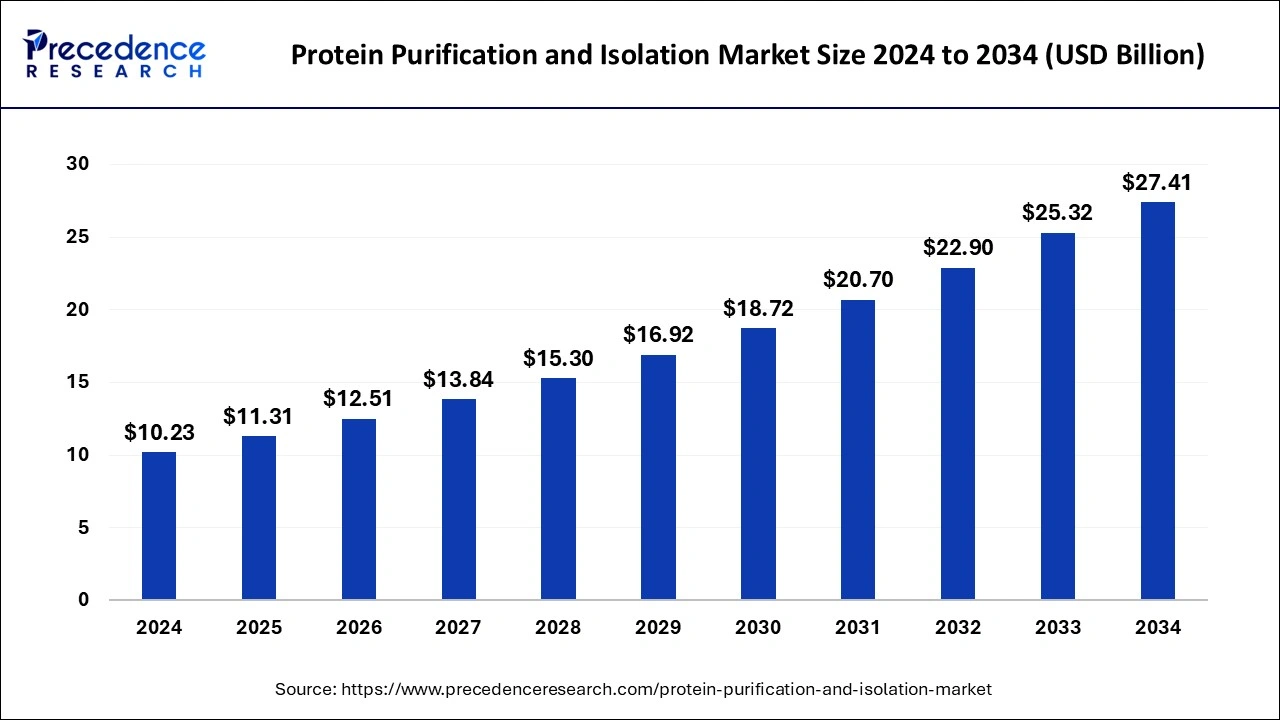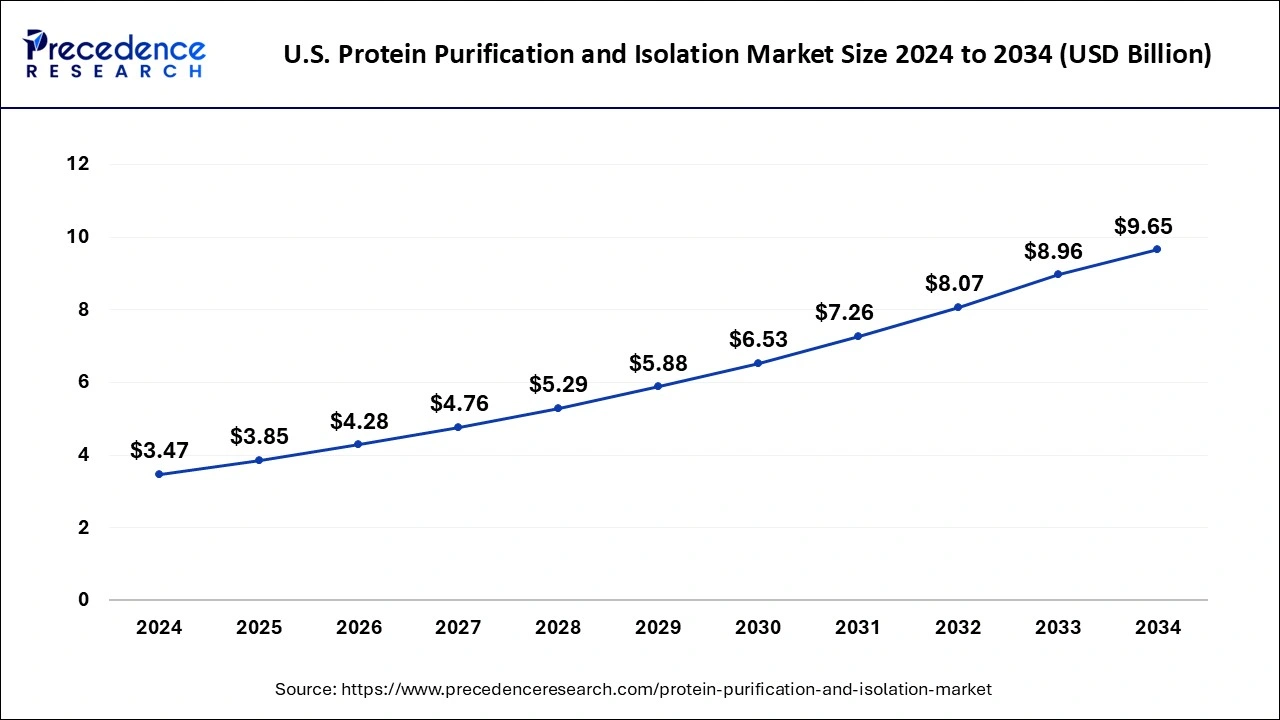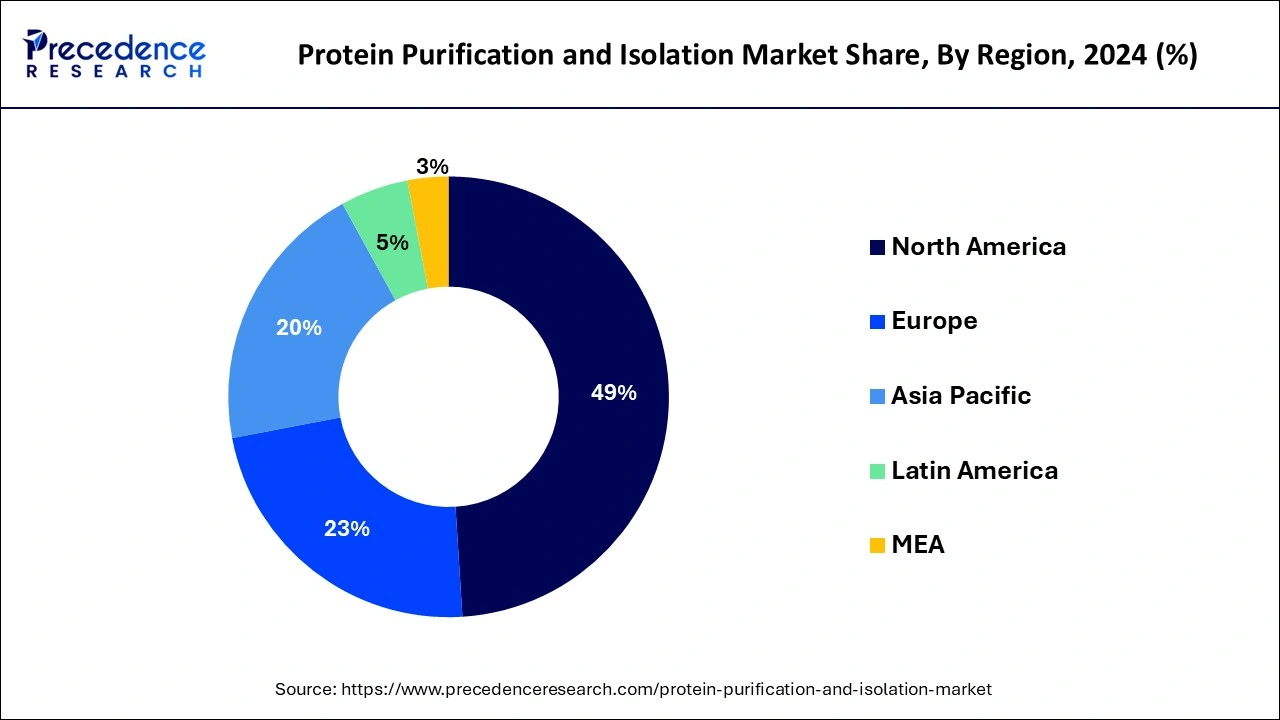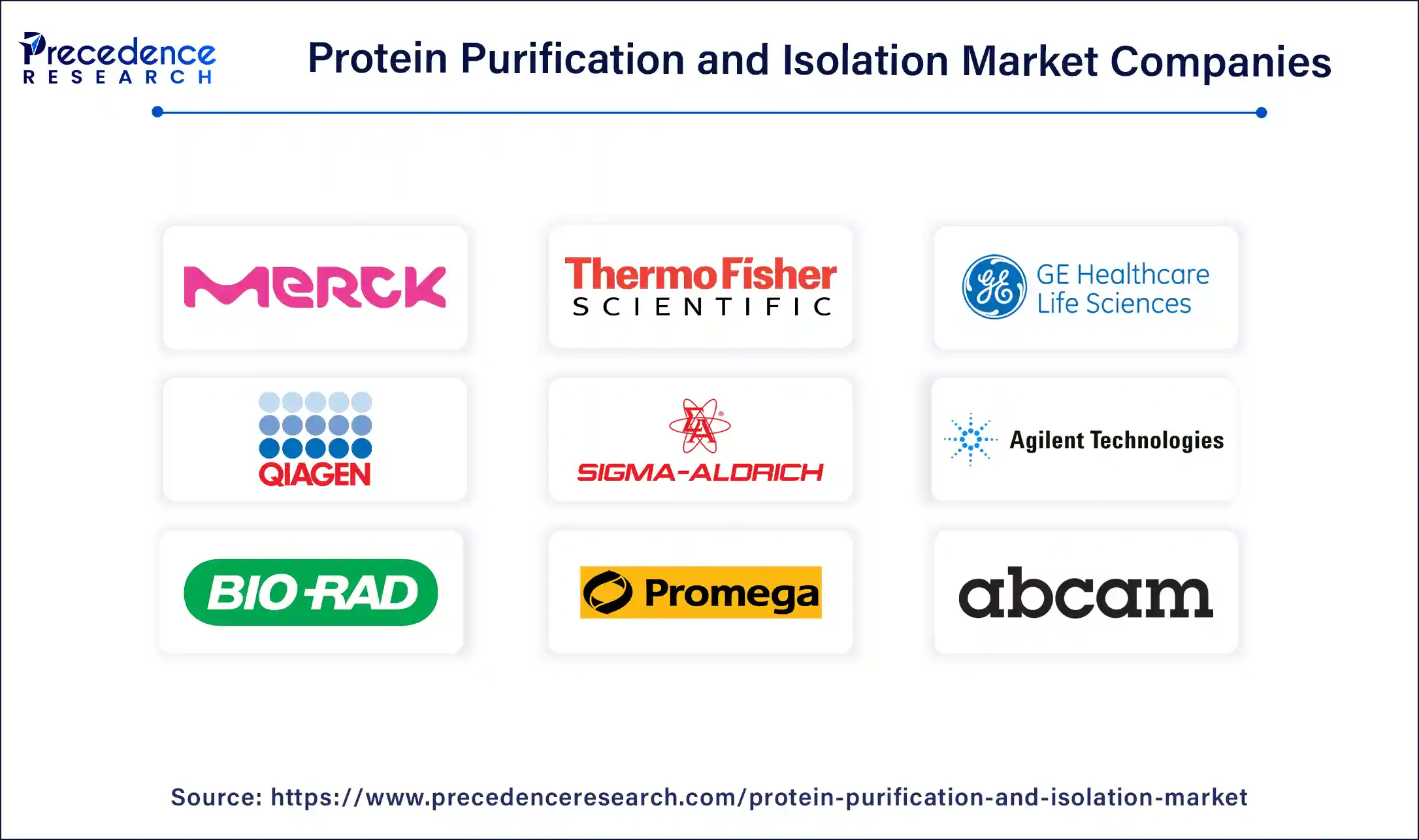November 2024
The global protein purification and isolation market size is calculated at USD 11.31 billion in 2025 and is forecasted to reach around USD 27.41 billion by 2034, accelerating at a CAGR of 10.36% from 2025 to 2034. The North America protein purification and isolation market size surpassed USD 5.01 billion in 2024 and is expanding at a CAGR of 10.40% during the forecast period. The market sizing and forecasts are revenue-based (USD Million/Billion), with 2024 as the base year.
The global protein purification and isolation market size was accounted for USD 10.23 billion in 2024, and is expected to reach around USD 27.41 billion by 2034, expanding at a CAGR of 10.36% from 2025 to 2034. The protein purification and isolation market is growing because it allows the obtainment of the protein wanted by separating it from other proteins. They often need to be obtained in pure form to determine their function and interpret their properties.

The application of machine learning and other artificial intelligence technologies to protein research has led to groundbreaking advances in functional areas such as cellular and proteome homeostasis, which are essential to the success of life. The combination of human intelligence and precision with the capabilities of machine learning has expanded the horizons of epistemology and has yielded benefits such as significant advances in protein structure prediction. Recent advances in molecular biology technologies, particularly protein structure prediction, are revolutionizing drug discovery and development. AI can also help improve workflows for protein purification, separation and extraction, microscopy analysis, and flow cytometry. AI algorithms can predict the optimal protein purification strategy from data, reducing the number of repeated experiments. In photography, AI can enable image analysis, providing faster access to valuable information. The combination of AI and protein structure prediction has accelerated the understanding of protein folding, function, and interactions. These AI-powered models have spread to a variety of scientific fields, from biochemistry to drug discovery, driving the growth of the protein purification and isolation market.
The U.S. protein purification and isolation market size was estimated at USD 3.47 billion in 2024 and is predicted to be worth around USD 9.65 billion by 2034, at a CAGR of 11.1% from 2025 to 2034.

North America accounted for the larger market share during the forecast period owing to the increasing number of pharmaceutical companies, the presence of sophisticated research infrastructure, rising number of acquisition & collaboration among major players, and increasing investment from both private and public sectors focusing on developing innovative products.
Additionally, North America has witnessed a rise in research and development activities in the field of life sciences, including proteomics and genomics research. This has created a demand for advanced protein purification and isolation techniques to support the discovery and development of new drugs and therapies in recent years.

On the other hand, the Asia Pacific market is growing at a significant CAGR during the forecast period owing to increasing government support in developing countries such as India, Japan, and China for the development of healthcare infrastructure and increasing expenditure for the development of novel purification and isolation methods.
Many global pharmaceutical and biotechnology companies are outsourcing their research and manufacturing activities to countries in the Asia Pacific region due to lower costs and the availability of skilled labor. This outsourcing trend is accelerating the demand for protein purification and isolation technologies in the region.
Protein purification and isolation is a set of procedures undertaken, especially for dividing/separating a specific type of protein from a complicated mixture. Usually, the protein purification and isolation process is done during the protein, tissue, or cell studies. Such a process allows the separation, concentration, elimination, and stabilization of various proteins from impurities, including nucleic acid and viruses. Proteins are macromolecules that enable the maintenance of structures and the functional integration of the cell.
Protein purification and the isolation and identifying proteins and other compounds have been obtained using chromatography. A protein isolation procedure involves a series of steps where the protein progresses in purity with each step. The fine-resolution techniques such as chromatography offer the final product. Chromatography is one of the most crucial purifying techniques and this is a result of its many advantages compared to other purifying techniques. Chromatography is considered a convenient method for trapping diluted molecules in a highly diluted solution.
Protein purification is a method of isolating proteins from other biological molecules present in a particular sample. The purification process isolates the protein and non-protein parts of the mixture and lastly isolates the required protein from all other proteins. Purified proteins help in studying as well as understanding their enzymology and affinity for specific substrates. Protein Purification is crucial to comprehend the structure and function of several proteins. It is also vital for the development of clinical biosensors and depends on pure protein as a detection agent. Protein isolation is the method of extracting proteins from a particular sample. Protein purification is important for characterizing the structure, function, and interactions of the needed protein. Purifying a single protein from a complex mixture, more times than not a series of separation steps, based on several characteristics used unless a pure protein is obtained. A protein isolation goal is to safely and efficiently isolate the needed protein from a mixture.
The separation of proteins is done from samples of insects, mammals, plants, bacteria, and others. There are usually four steps involved in protein purification including cell lysis, protein binding to a matrix, washing, and elution. Protein purification is a basic step for analyzing individual proteins and protein complexes as well as finding interactions with other proteins RNA or DNA.
| Report Coverage | Details |
| Market Size in 2025 | USD 11.31 Billion |
| Market Size by 2034 | USD 27.41 Billion |
| Growth Rate from 2025 to 2034 | CAGR of 10.36% |
| Largest Market | North America |
| Base Year | 2024 |
| Forecast Period | 2025 to 2034 |
| Segments Covered | By Product, By Technology, By Application, and By End-users |
| Regions Covered | North America, Europe, Asia-Pacific, Latin America, and Middle East & Africa |
Increasing government investment in research & development and favorable initiatives
Government investment in R&D provides financial support to researchers, scientists, and institutions involved in protein purification and isolation. This funding enables the development of innovative technologies, methodologies, and equipment, ultimately driving advancements in the field.
Government initiatives may focus on building state-of-the-art research infrastructure, such as specialized laboratories, research centers, and biotechnology parks. These facilities can support protein purification and isolation research by providing access to advanced instruments, equipment, and resources needed for efficient protein separation and analysis. Governments often establish collaborative research programs that bring together academic institutions, research organizations, and industry players. Such initiatives foster knowledge sharing, interdisciplinary collaborations, and the exchange of ideas and expertise.
High cost of tools and instrument
The high/excessive cost of tools and instruments used in the protein purification and isolation market is observed as a major restraint for the market’s growth. Protein purification and isolation techniques often require the use of specialized and sophisticated tools and instruments such as chromatography systems, electrophoresis tools, and automated liquid handling equipment. These instruments can be expensive to purchase, install, and maintain. The high cost of these capital investments can deter smaller research laboratories or companies with limited budgets from entering the market or expanding their operations.
The high cost of tools and instruments directly affects the final cost of protein purification and isolation services and products. End-users, such as academic researchers, biotechnology companies, and pharmaceutical manufacturers, may be working on small-scale, be price-sensitive and have limited budgets. If the cost of protein purification and isolation becomes too high due to expensive tools and instruments, it can impact market demand and hinder the growth of the industry.
Technological advancements are expected to boost the market growth
The rapid advancement in technology is expected to boost the growth of the global protein purification and isolation market during the forecast period. Magnetic and protein beads and ligand tagging systems are highly preferred over conventional methods. In addition, increasing demand for purification kits in rapid screen tests, shifting towards advanced instrumentation for protein purification. In recent years, various purification techniques have been developed, such as Salting Out, Dialysis, Gel-Filtration Chromatography, Ion-Exchange Chromatography, Affinity Chromatography, and High-Pressure Liquid Chromatography.
Prominent market players are focusing on developing novel technologies for protein purification. For instance, in August 2022, a leading player in the market, Bio-Rad Laboratories announced the launch of Econofit, a platform for low-pressure prepacked chromatography columns. The newly launched platform promotes the screening of protein purification experiments.
The consumables segment is predicted to grow at the most significant rate during the forecast period. Protein purification and isolation kits, reagents, magnetic beads and resins are widely used in the purification and isolation process that lie under the consumable category. Such products are convenient, easy to use, easily available and offer precise results with various other benefits.
On the other hand, the instruments segment is projected to expand at a rapid rate owing to the development of portable and accurate instruments. With the technological advancements in the overall biotechnology industry, the instruments and tools in the protein purification and isolation demand advancements and innovation, such demands are observed to fuel the growth of the segment.
The Chromatography segment is expected to lead the market during the forecast period. Chromatography is one of the most commonly and widely utilized techniques for the isolation and purification of proteins. Chromatography techniques generally involve mild conditions, such as physiological pH and temperature, which minimize the denaturation or degradation of proteins during the purification process. This is particularly crucial for maintaining the structural and functional integrity of delicate proteins. Chromatography is considered the most ideal technique in the market as it provides excellent resolution, enabling the separation of proteins with similar molecular weights or similar characteristics. By utilizing various separation mechanisms and optimizing the chromatographic conditions, it is possible to achieve high-resolution protein separation.
On the other hand, the ultrafiltration segment is expected to increase at a notable rate during the forecast period. Ultrafiltration is the process of isolating minor particles and dissolved molecules from liquids. Ultrafiltration is widely used for the isolation of proteins from buffer components. the advantages offered by ultrafiltration for protein purification and isolation techniques act as a driver for the segment’s growth. The ultrafiltration technology offers the generation of rapid results in the protein purification and isolation market.
The global protein purification and isolation market is segmented into drug screening, biomarker discovery, protein-protein interaction studies, and diagnostics. The Protein-protein interaction studies segment is predicted to register the fastest growth rate during the forecast period due to the rapid adoption of such techniques for obtaining highly purified proteins. Protein-protein interactions are the physical connection between two or more proteins, and they also offer the representation of complex biological functions.
On the other hand, the drug screening segment is expected to grow at a notable rate during the forecast period owing to the rising utilization of discovering novel drugs with different applications. Drug screening offers the development of drugs with high efficiency.
Based on the end users, the academic and research institutes segment is expected to witness the fastest growth during the forecast period. The rising government as well as private fundings for academic research institutions for the development of advanced technologies in biotechnology industry is held as a major factor for the segment’s growth. Moreover, multiple research institutions are actively participating in the rapid adoption of isolation as well as purification technologies, this accelerates the segment’s growth.
In addition, the shifting focus by academics and research institutes on detailed kinetic analysis and advanced protein purification systems will fuel the segment’s growth during the forecast period.

By Product
By Technology
By Application
By End Users
By Geography
For inquiries regarding discounts, bulk purchases, or customization requests, please contact us at sales@precedenceresearch.com
No cookie-cutter, only authentic analysis – take the 1st step to become a Precedence Research client
November 2024
September 2024
November 2024
August 2024